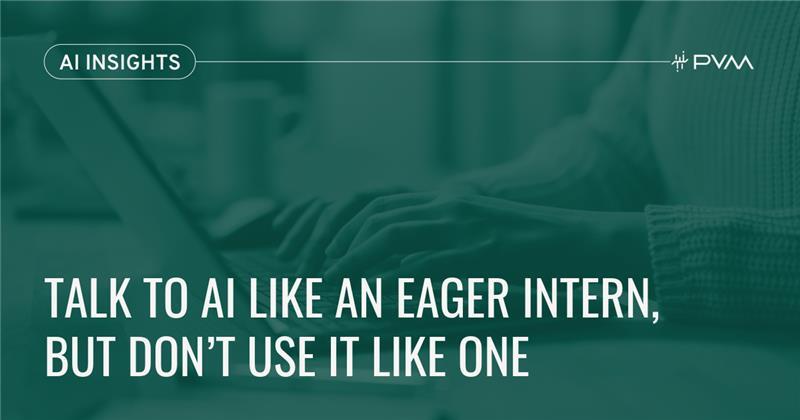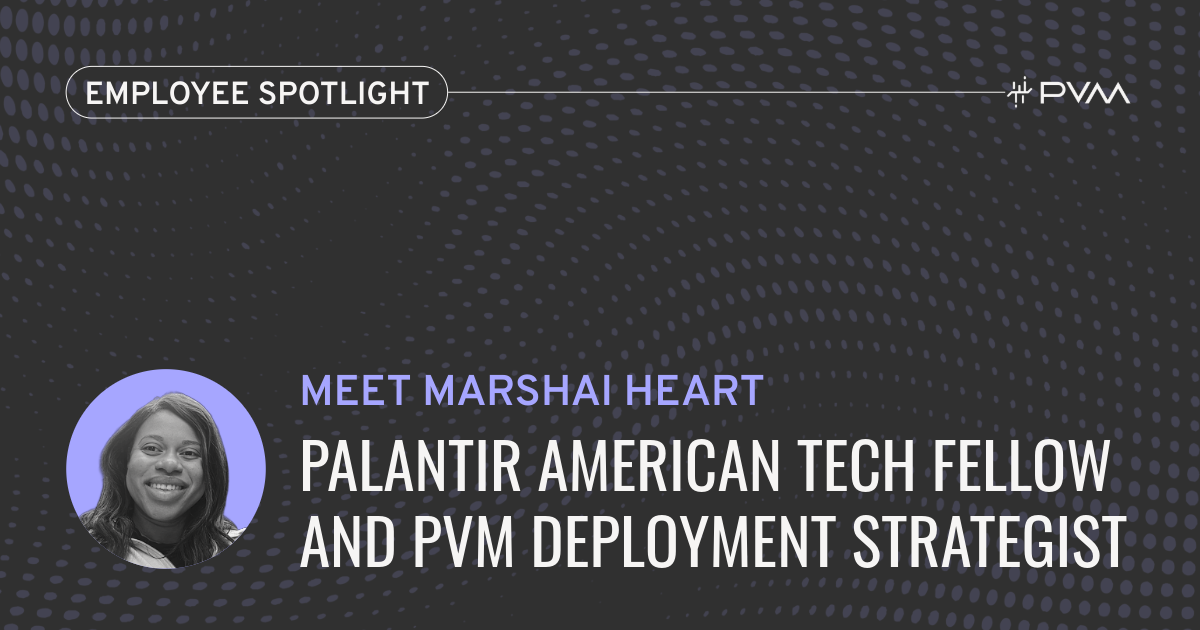Talk to AI Like an Eager Intern, But Don’t Use It Like One
By Sydney Metzmaker AI is often described as an intern: eager, capable, and full of potential, but in need of specific direction and a bit of...
I NEED HELP WITH...
I'M WORKING WITH...
INDUSTRIES

At PVM, we have extensive experience unlocking the power of data and helping our clients achieve their missions in federal, state, and local governments, as well as commercial sectors. In today's data-driven world, organizations across all sectors recognize that their success hinges on harnessing the full potential of their data.

ABOUT US

In an era where data drives decision-making, organizations increasingly understand the necessity of a robust data management strategy and platform to effectively connect data to actions and decisions. Yet, many teams are asking, “What’s next?” How can public sector teams leverage their data and the latest technologies to transform their operations and deliver meaningful outcomes?
Artificial intelligence and large language models are necessary to answer those critical operational questions—but it can be challenging to figure out how to effectively implement these technologies for each unique use case.
To help, PVM is hosting immersive, hands-on bootcamps to help public sector teams learn how to use artificial intelligence and advanced analytics to their advantage. Recently, PVM hosted one of these bootcamps with the Centers for Disease Control and Prevention (CDC) Mycotic Diseases Branch (MDB). Together, we successfully demonstrated the new technology functionality that PVM and MDB built together, exposed new team members to the technology that they have available to them, and explored how to apply artificial intelligence for a specific public health use case.
Read on to learn more about the bootcamp, and click here to schedule your own with PVM.
Over the past year, PVM has partnered closely with MDB to enhance fungal disease surveillance workflows by reshaping existing views and incorporating new variables within MDB’s Data Collation and Integration for Public Health Event Response (DCIPHER) platform, built on the Palantir Platform. This platform has since been renamed the One CDC Data Platform.
This project focused on creating impactful ontology variables to enhance the workflows for various surveillance programs:
Invasive Mold Infections Surveillance:
Candidemia Surveillance:
Endemic Fungal Diseases Surveillance:
To support external partners, PVM established new user groups and centralized, collaborative applications for situational awareness and decision making. These user groups were configured to respect restricted access guidelines, with a bulk upload tool for high-volume data entry and an automated data quality check step to ensure clean, standardized data. The centralized application enabled external users to access, upload, query, analyze, and automatically generate reports on their data, with standardized visualizations and dashboard views for all pathogens. This included clear distinctions of data sources for variables originating from multiple streams, ensuring a cohesive and efficient user experience.
"Our experiences with PVM, including the recent bootcamp, have been a way to re-engage and teach staff to utilize DCIPHER and streamline work that historically has been very manual and labor intensive,” said MDB Deputy Branch Chief Nancy Chow.
At the conclusion of the project described above, MDB had some additional needs and requirements they wanted to partner with PVM to solve. Specifically, they were looking to expand the new workflows and dashboards to more users within the branch and to sketch out a potential solution for disease cluster detection. PVM hosted a Palantir Platform Bootcamp with MDB and the DCIPHER Platform Support Team at CDC headquarters in Atlanta to address both of these needs.
For this bootcamp, PVM had a larger audience than just those team members we worked with for the project described above—including some team members who were not yet using the DCIPHER platform themselves.
During the bootcamp, PVM showcased the advancements made over the past year in MDB's Mold, Candidemia, and Endemics epidemiology workflows, highlighting enhanced data collection methods, pipelining, dashboarding, and reporting. The event also demonstrated DCIPHER's intuitive point-and-click capabilities for data ingestion, transformation, analysis, visualization, and sharing, making powerful tools accessible to less-experienced users. Participants were trained on leveraging the platform and its new workflows, dashboards, and integrations, empowering them to fully utilize DCIPHER's capabilities in their mission-critical work.
This activity enabled MDB to maximize their investment in the DCIPHER platform and learn how to better leverage the technology they already have to increase data-driven decision making throughout the branch.
In addition to wanting to increase DCIPHER adoption throughout the branch, MDB also was looking for a new way to identify potential candidemia infection clusters or anomaly detection, a use case PVM tackled with subject matter experts through Palantir’s Artificial Intelligence Platform, which enables organizations to responsibly and securely integrate operationalize large language models and other AI alongside data, business logic, and workflows.
During the bootcamp, PVM and MDB walked through this specific use case together, demonstrating how DCIPHER’s AIP tools can surface key insights and enable the branch to quickly and effectively identify candidemia clusters and make recommendations to protect public health.
"Our work with PVM and the AIP bootcamp was a fantastic window into how we can use DCIPHER's built-in AI tools to help us get actionable insights from our data,” said MDB Data Science and Informatics Unit Lead Malavika Rajeev about the bootcamp. “PVM highlighted both the strengths and limitations of these tools and how we could apply them to real life use cases that we encounter in our work."
CDC MDB Epidemic Intelligence Service Officer Elizabeth Sajewski attended the bootcamp and shared her thoughts.
“The PVM AIP bootcamp was a valuable experience. The bootcamp had a great structure to support learning for a diverse group of DCIPHER users across MDB -- from those with very limited experience to everyday users -- which combined orientation to Palantir and the DCIPHER/Foundry platform with hands-on exercises using AIP so everyone could take away a greater understanding of DCIPHER and appreciation for how to use it.
Hannah Zenas from PVM and Ciara Baumert from Palantir were particularly helpful. I loved analogies that Hannah made throughout the bootcamp -- particularly to treat AI like an eager intern -- this really helped me to consider how we can better work with AI and what kinds of questions to ask and prompt engineering we can do to make better use of AI. She also adeptly led the hands-on exercises, helping us all to work through MDB-specific examples to understand how we could apply AIP to our own work. Hannah and Ciara were also very responsive to questions. Ciara added a great depth of knowledge from the Palantir side. It was so helpful to be able to ask questions in real-time and get answers to things I'd been wondering about over a year of working in DCIPHER. Plus, the bootcamp and questions and responses really helped me to better understand AI in general, as well as how to specifically apply AI through DCIPHER to MDB work.
I appreciated the orientation to Palantir, it's use across industries and government, and the ‘tech stack’ of modular technology components that Palantir platforms are built on. This introduction helped me better appreciate the power and versatility of Palantir and the different ways we can make better use of DCIPHER, a Palantir Foundry platform.
Following this bootcamp, I have brought up DCIPHER and suggested expanded use of DCIPHER in several meetings and to colleagues in MDB, DFWED, and even more broadly across CDC, particularly regarding the tools I learned about during this bootcamp. I am better equipped to use DCIPHER for existing projects. Even more significantly, I can imagine how new projects could be designed to leverage this technology, to make more complete use of data, and to explore questions using the low-coding, AI driven capabilities of DCIPHER. AIP Assist [a resource that allows users to interact with platform capabilities, like documents, apps, code, in natural language thus lowering the barrier to entry and streamlining implementation] has been helpful to further customize and adapt existing dashboards to see our data and drive new questions and further investigation. In the workshop, we discussed how your data can talk to you and now, with DCIPHER and this bootcamp, I feel like me and my data are definitely in better conversation.”
This is just one example of how PVM’s bootcamp program has helped our clients both maximize their technology investments and explore how advanced technologies like artificial intelligence can help them achieve their mission objectives.
“We are excited about using these bootcamps to help users leverage an expanded set of AI-backed platform tools so subject matter experts and their teams can implement new capabilities quickly and drive maximum impact for public health,” said Eric Heller from Palantir. “Over the course of just a couple days, teams have used these bootcamps to rapidly familiarize themselves with the platform, as well as deploy actual, working prototypes for scoped use cases. Through this format, we've seen a dramatic increase in speed to value for users, with teams accomplishing in days what could often take months.”
Learn about PVM’s immersive, hands-on Palantir Platform bootcamps and schedule your own here.

By Sydney Metzmaker AI is often described as an intern: eager, capable, and full of potential, but in need of specific direction and a bit of...

We sat down with Marshai Heart, a recent graduate of Palantir’s American Tech Fellowship who has since joined PVM as a Deployment Strategist. With...

By Sydney Metzmaker When agencies take on data modernization or implement a new technology platform, the instinct is often to think big. Leaders...